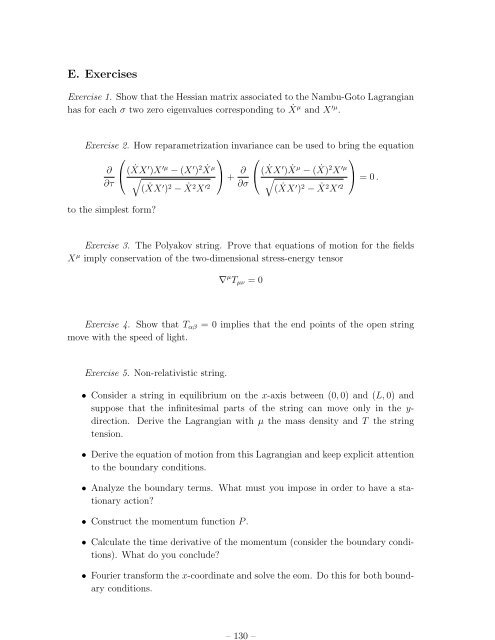Lectures on String Theory
Lectures on String Theory
Lectures on String Theory
Create successful ePaper yourself
Turn your PDF publications into a flip-book with our unique Google optimized e-Paper software.
– 130 –<br />
E. Exercises<br />
Exercise 1. Show that the Hessian matrix associated to the Nambu-Goto Lagrangian<br />
has for each σ two zero eigenvalues corresp<strong>on</strong>ding to Ẋµ and X ′µ .<br />
Exercise 2. How reparametrizati<strong>on</strong> invariance can be used to bring the equati<strong>on</strong><br />
⎛<br />
⎞ ⎛<br />
⎞<br />
∂<br />
⎝ (ẊX′ )X ′µ − (X ′ ) 2 Ẋ µ<br />
√<br />
⎠ + ∂ ⎝ (ẊX′)Ẋµ − (Ẋ)2 X ′µ<br />
√<br />
⎠ = 0 .<br />
∂τ<br />
(ẊX′ ) 2 − Ẋ2 X ′2 ∂σ<br />
(ẊX′ ) 2 − Ẋ2 X ′2<br />
to the simplest form?<br />
Exercise 3. The Polyakov string. Prove that equati<strong>on</strong>s of moti<strong>on</strong> for the fields<br />
X µ imply c<strong>on</strong>servati<strong>on</strong> of the two-dimensi<strong>on</strong>al stress-energy tensor<br />
∇ µ T µν = 0<br />
Exercise 4. Show that T αβ = 0 implies that the end points of the open string<br />
move with the speed of light.<br />
Exercise 5. N<strong>on</strong>-relativistic string.<br />
• C<strong>on</strong>sider a string in equilibrium <strong>on</strong> the x-axis between (0, 0) and (L, 0) and<br />
suppose that the infinitesimal parts of the string can move <strong>on</strong>ly in the y-<br />
directi<strong>on</strong>. Derive the Lagrangian with µ the mass density and T the string<br />
tensi<strong>on</strong>.<br />
• Derive the equati<strong>on</strong> of moti<strong>on</strong> from this Lagrangian and keep explicit attenti<strong>on</strong><br />
to the boundary c<strong>on</strong>diti<strong>on</strong>s.<br />
• Analyze the boundary terms. What must you impose in order to have a stati<strong>on</strong>ary<br />
acti<strong>on</strong>?<br />
• C<strong>on</strong>struct the momentum functi<strong>on</strong> P .<br />
• Calculate the time derivative of the momentum (c<strong>on</strong>sider the boundary c<strong>on</strong>diti<strong>on</strong>s).<br />
What do you c<strong>on</strong>clude?<br />
• Fourier transform the x-coordinate and solve the eom. Do this for both boundary<br />
c<strong>on</strong>diti<strong>on</strong>s.

















